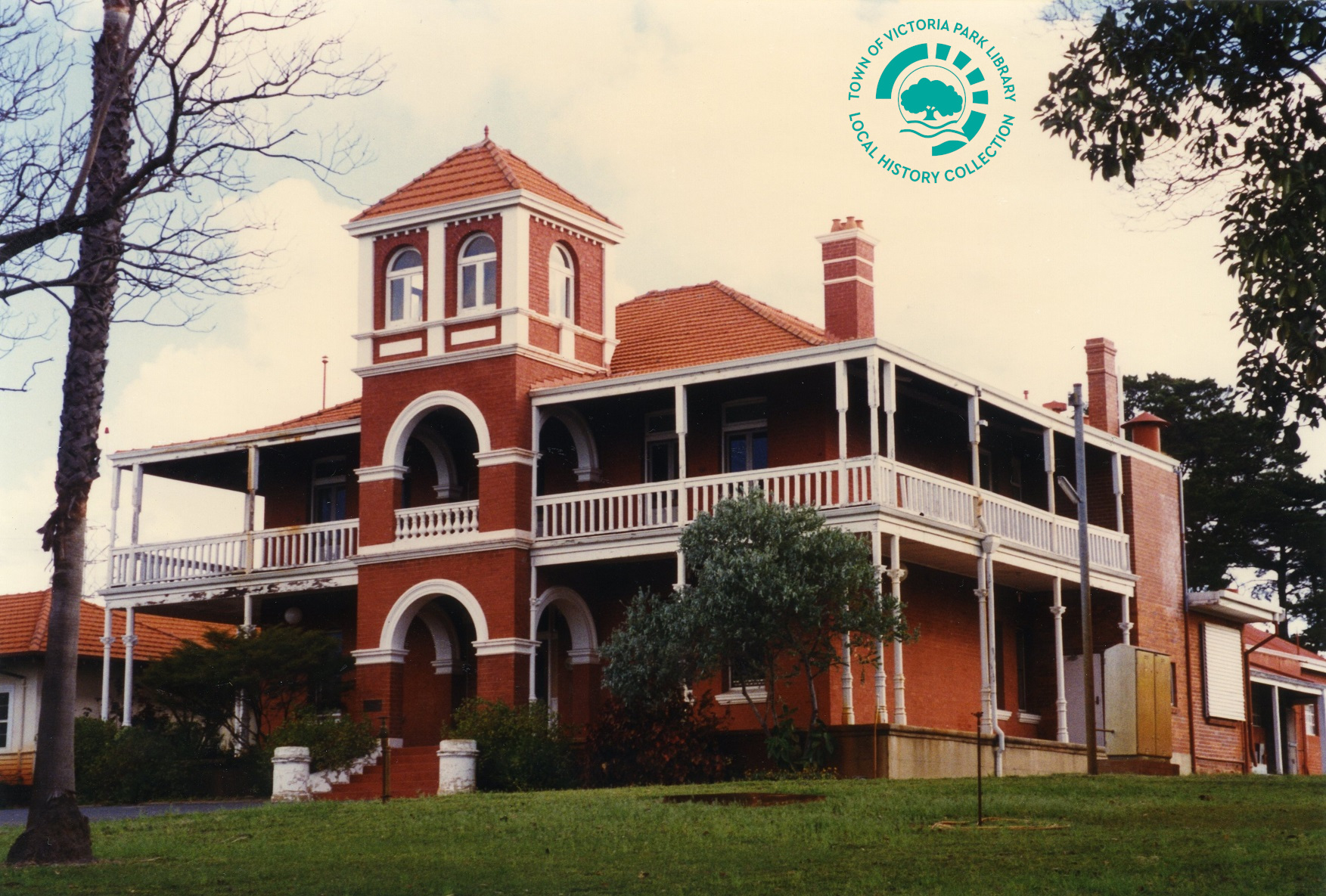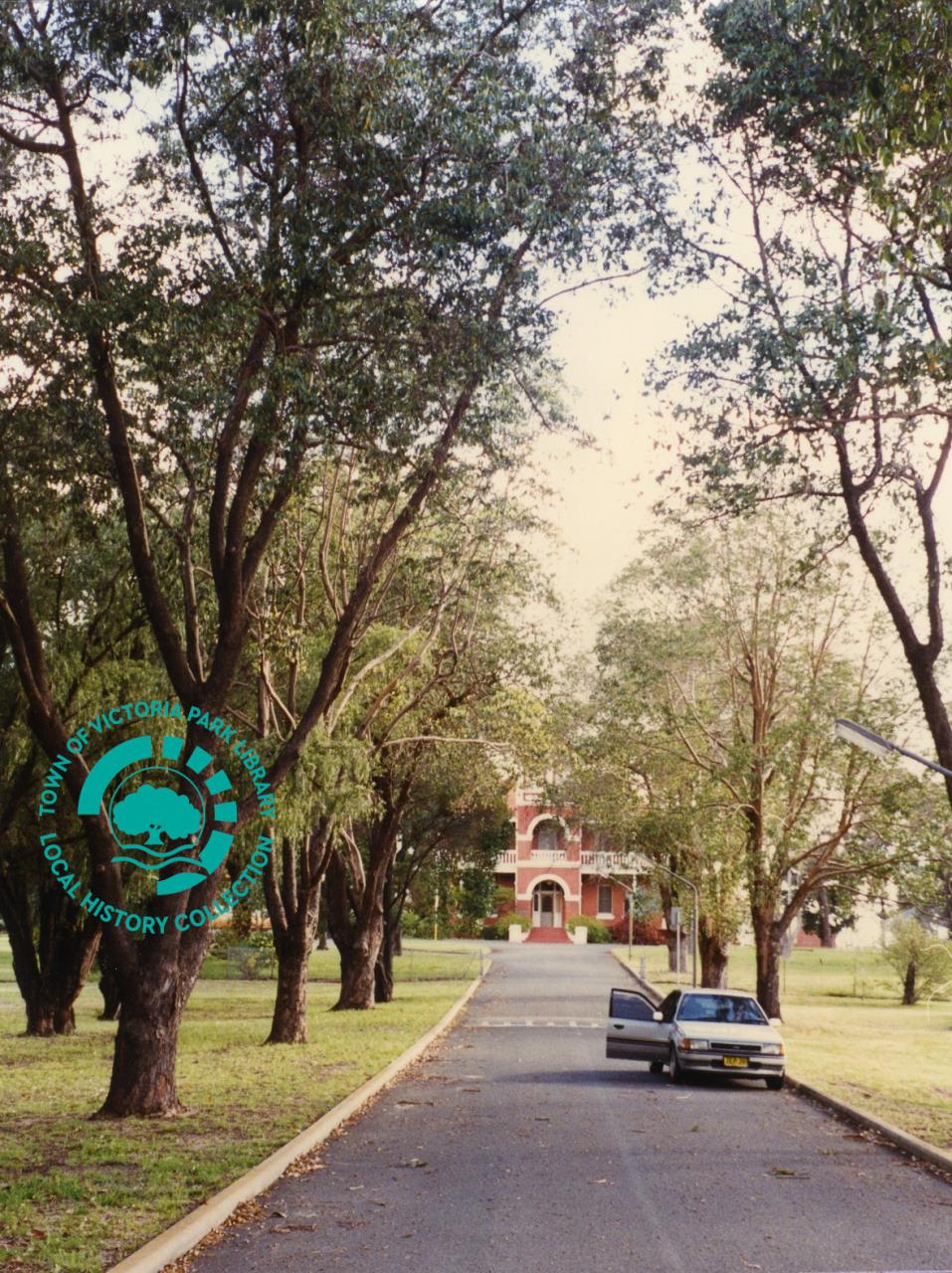Published on Tuesday, 20 May 2025 at 7:00:00 AM
Welcome to #TimeWarpTuesday! This week we bring to you the next part of our mini-series on heritage places from the Town’s Municipal Heritage Inventory (MHI) published in June 2000.
Heritage Places – Part 14
Edward Millen Hospital*
Address: 1005 Albany Highway (cnr Hillview Terrace), East Victoria Park
[*This building and surrounding grounds has recently been renamed Elizabeth Baillie House and Elizabeth Baillie Park. To avoid confusion and to protect the integrity of the original entry of this site in the Town’s MHI we will be using the name it was known by at the time the MHI was published in 2000.]

PH00254-01 Edward Millen Hospital, circa 1998.
Photographed by HeritageToday for the Town of Victoria Park Municipal Heritage Inventory, that was published in 2000.
“Historical Notes
“The land on which the Edward Millen Hospital now stands was originally part of a parcel of land of 5,320 acres granted to Samuel Bickley in 1842. In 1854, Bickley sold the land to Henry Manning for £532. The land was then bought under the Transfer of Land Act of 1874, and in January 1885 a Certificate of Title was issued to Lucius Manning of Fremantle. In quick succession, the land was bought and sold by an Adelaide syndicate and a Sydney syndicate. The Sydney and West Australian Freehold Land Company Limited bought the land with the intention of subdividing it, and selling the allotments. Lot C was bought by James Rae of Perth in 1893, and in 1911 the land was sold to Mrs Elizabeth Baillie of Victoria Park for £650. Nurse Baillie used the site to build the Rotunda Maternity Hospital.
“The maternity hospital was called the Rotunda Maternity Hospital and first appears in the 1912 Post Office Directory. The source of the name Rotunda is unknown. However, there is speculation that the name came from the Rotunda Hospital in Dublin, Ireland, a large Maternity Hospital with a good reputation renowned across Britain. Little can be found about the architect or builders of the hospital, although Mrs Baillie placed an advertisement in the West Australian on 4 May 1912, for 100,000 bricks (more or less) and the bricklayers to lay them. The labour ward was on the top floor of the building accessed by a flight of stairs.
“In 1919, the Spanish Influenza Epidemic hit Perth and the hospital was taken over by the State Government and run by the Perth Public Hospital. On 6 May 1920, the property and building became a compulsory purchase of the Commonwealth Government. At this time, the land approximately 31 acres, was considered to be worth £1,100 and the hospital buildings £3,700. Total estimated cost was £4,800 and Mrs Baillie was paid £5,000. The new owner was the Repatriation Department, and the hospital was a satellite of the Hollywood Repatriation Hospital. The existing building was converted to accommodation for the staff, and a wooden chalet style ward was added to accommodate sixteen tubercular patients.
“The hospital was named the Edward Millen Home, in 1924, in honour of the first Minister of Repatriation. The hospital then became a sanatorium for ex-service personnel who had contracted tuberculosis. In 1936, further additions to the hospital were made in order to make space for more staff and patients, and two extra timber wards were added.
“Throughout 1934 and 1935, the plan for the extension of Berwick Street through Edward Millen Home land was discussed and debated by the Commonwealth Government and the City of Perth. The plan was the suggestion of Harold Boas (Chairman of the Town Planning Committee) and W E Bold (Town Clerk of the City of Perth). In 1936, the agreement was signed between the Commonwealth of Australia and the City of Perth that the Commonwealth would sell the City thirteen acres of land for £500, to use for the road extension and for a park.
“During 1942, when the war scare was at its height, the patients at the home were transferred to Wooroloo and the property handed over to the Perth Hospital Authorities. However, accommodation was in short supply at Wooroloo so the tubercular patients were bought back to the Edward Millen Home in 1943, though control of the sanatorium remained in the hands of the State Government. This remained the case until 1949, when the Repatriation Commission again took control of the Home, and it continued as a sanatorium for TB patients. In 1960, the patients were all transferred to the Hollywood Repatriation Hospital, and the Edward Millen Home was converted to a hospital for special cases of patients not requiring the full nursing or medical attention of a general hospital.
“A new building (‘D’ Ward) was added in 1968, for the use of psychiatric patients, and was used for this purpose until 1971, when those admissions were discontinued. It then housed the physiotherapy and occupational therapy departments, an office, a dining room, lounge and eight beds.
“The Edward Millen Home remained part of the Repatriation Department until 1982, when the Health Department took over. In 1984 the Edward Millen Hospital was renamed Hillview and opened as a division of the Mental Health Services. It brought together 4 units of the Child and Adolescent Psychiatry Divisions. The Edward Millen Home (Hillview) in 1998 stood unoccupied and was the much discussed centre of a number of proposals for future development.

PH00254-02 The tree lined driveway leading up to Edward Millen Home, circa 1998.
Photographed by HeritageToday for the Town of Victoria Park Municipal Heritage Inventory, that was published in 2000.
“Description
“Edward Millen Hospital is situated well back from Albany Highway and can be entered via a long drive lined with an avenue of trees. A large parkland is located at the foreground of the hospital. The trees are varied and mostly quite old. The grounds are well kept and include a children’s playground.
“The brick building is two-storey with a tile covered roof and verandahs on three sides supported by cast iron posts. The interior features a jarrah staircase, pressed metal ceilings, mosaic tiles on the front porch, and stained and leaded glass panels in the front door. The kitchen has been modernised, the iron lace on the balcony has been replaced with asbestos, and various additions have been made at the rear of the building.
“Statement of Significance
“The Edward Millen Hospital has aesthetic, social and historic heritage significance. It maintains a prominent situation being well set back from Albany Highway within large grounds. Architecturally the hospital has a style unique to the Victoria Park district. The social and historic value of the hospital is found in the long ties with supplying medical services, first as a maternity hospital and then as a repatriation service for returned soldiers with mental problems. Psychiatric services continued into the 1990s” (1).
Do you have memories or photos of Edward Millen House, recently renamed Elizabeth Baillie House? We’d love to hear about it and see photographs if you have any. Please get in touch via telephone: 08 9373 5500, email: vicparklibrary@vicpark.wa.gov.au or in person at 27 Sussex Street, East Victoria Park.
#LoveVicPark

PH00254-03 Other buildings in the [Edward Millen] complex, circa 1998.
Photographed by HeritageToday for the Town of Victoria Park Municipal Heritage Inventory, that was published in 2000.
Reference:
- Heritage Today 2000, ‘Town of Victoria Park Local Heritage Inventory’, Heritage Today, Mount Lawley, pp. 143- 147.
Back to All News